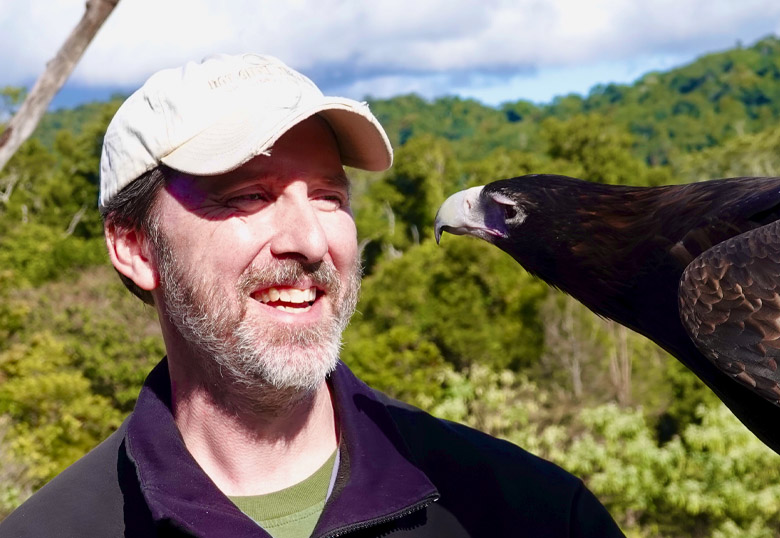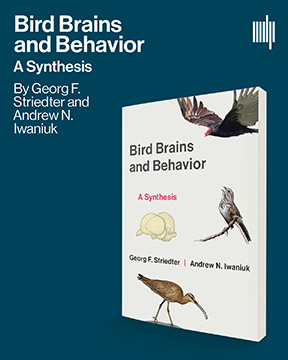Have you ever wondered how hummingbirds can hover in place or fly backward; seen chickadees and blue jays tucking away food for winter snacks; or questioned the ability of birds to problem solve their way into garbage and food containers?
University of Lethbridge professor Dr. Andrew Iwaniuk (Department of Neuroscience), a Board of Governors Research Chair in Comparative Neuroscience, has seen it all when it comes to bird behaviour — but more importantly, he’s studied the brains of these incredible animals to understand why and how they perform these remarkable tasks.

It was the lack of information on bird brains that intrigued Iwaniuk when he first took up studying the creatures. He originally had done extensive research work on the feeding behaviour of wallabies, kangaroos and their relatives while completing an honours thesis at Monash University in Australia and then on the feeding behaviour of carnivores for his Master of Science at ULethbridge.
“I realized we knew all these things about the anatomy of mammal brains but there was this whole group of other animals that shared a number of behaviours with mammals,” he says. “Birds have complex social relationships, they have biparental care, they use tools, they can solve problems and then they have other behaviours that are entirely unique like migrating between the poles, being able to fly and being able to survive in a range of different conditions that essentially mammals just cannot.”
Birds, and their behaviours, have been experiencing a surge in popularity in recent years, born out of the pandemic when people, confined to their homes, started to notice their surroundings more — and one commonality was the presence of birds.
“There’s a lot more citizen science happening now than ever before,” says Iwaniuk, who says he is regularly asked questions about birds by community members if he’s observing them or taking pictures while walking his dogs.

“We’ve also seen a lot of public media campaigns in recent years about our effects on birds, which has raised awareness. There’s a lot more concern about window collisions and what happens with birds landing in tailing ponds, as well as the efforts of wildlife rehabilitation centres.”
Iwaniuk and colleague Dr. Georg F. Striedter (professor of neurobiology and behavior, University of California, Irvine) have co-authored a new book that “marries the enthusiasm of bird enthusiasts for the what, how and why of avian behavior with the scientific literature on avian biology, offering the newest research in an accessible manner.”
Bird Brains and Behaviour is published by MIT Press and available Aug. 5.
“We’ve tried to aim for people with some science background, people who are keenly interested in birds and who may have some familiarity with the basics of evolutionary biology or bird behaviour,” says Iwaniuk.
The book delves into the process of how birds have evolved, what makes them different from other types of invertebrate animals and then examines the components of the bird brain and how it differs from the mammalian brain.
“What’s the most quintessential feature of a hummingbird — hovering. There's obviously a motor component to that, but in order to maintain that really stable position is dependent on their vision, and that is dependent on a very specific brain region that responds to how an animal is moving through space,” explains Iwaniuk.
He compares how the hummingbird moves to that of humans as they walk or ride a bike.
“We’re tracking our movement through space, feeding that information into spatial memory networks so we can work out where we are and where we’re going. This allows us to figure out whether we’re accelerating, decelerating, turning, all that essential feedback for how our eyes are moving and how we’re detecting things with our semicircular canals, which gives us a sense of balance. When you compare that to the brain of a hummingbird, you find that region of their brains is hugely enlarged and that’s what is allowing them to maintain their position.”
This, of course, is incredibly important because if hummingbirds could not maintain their position while feeding, they would pierce the flowers they feed on and lose the nectar they need to survive.
This is just one example of the fascinating behaviours his research has detailed and opens the door to many more explored in depth within the book.
“We started talking about putting this book together in 2022 and it took us a while to write up the first few chapters but when we shopped that around, MIT Press was very interested,” says Iwaniuk. “It’s exciting to have it finished and we’re really happy with MIT Press because they allowed us to add some features like QR codes throughout the book where you can scan them to link to videos that highlight specific behaviours and interviews with neuroscientists who actually work on bird brains.”
The ebook is available for free from MIT Press and the hard copy is available through most online and local bookstores.
